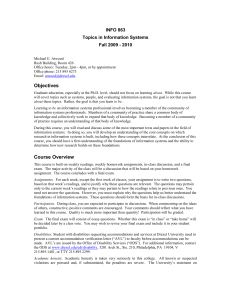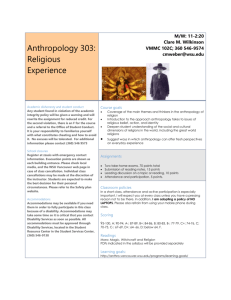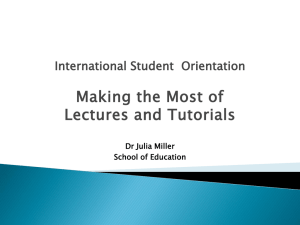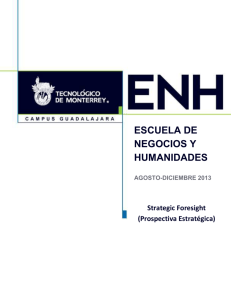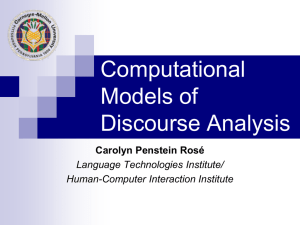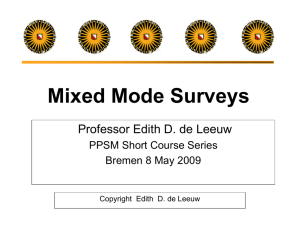data collection methods in survey research
advertisement
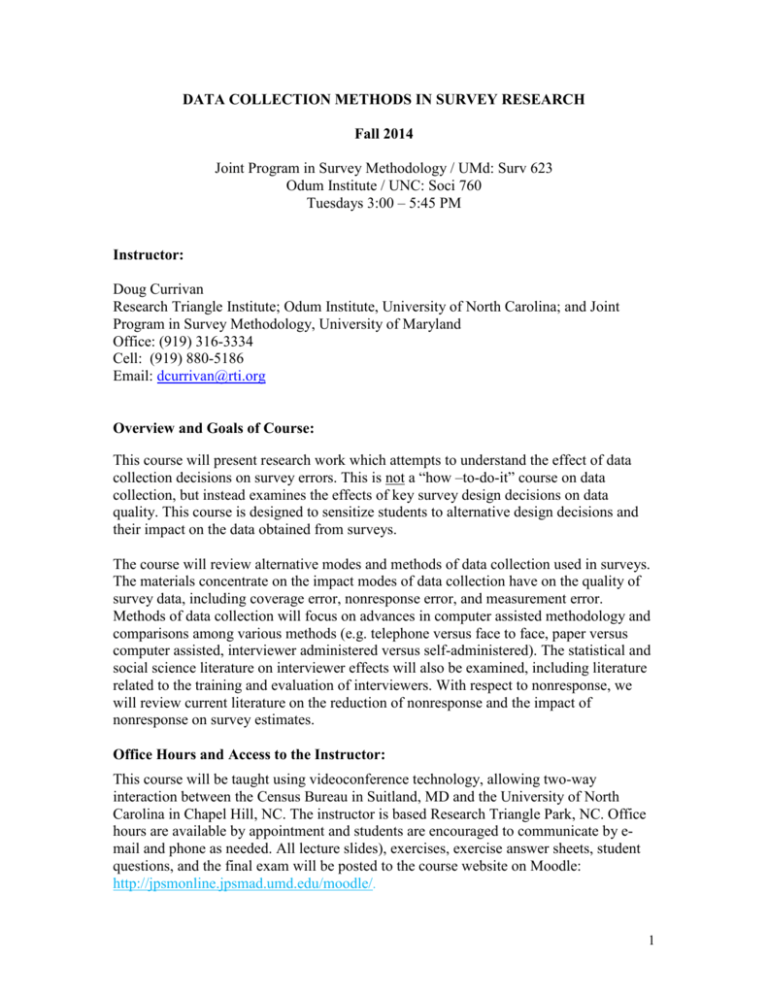
DATA COLLECTION METHODS IN SURVEY RESEARCH Fall 2014 Joint Program in Survey Methodology / UMd: Surv 623 Odum Institute / UNC: Soci 760 Tuesdays 3:00 – 5:45 PM Instructor: Doug Currivan Research Triangle Institute; Odum Institute, University of North Carolina; and Joint Program in Survey Methodology, University of Maryland Office: (919) 316-3334 Cell: (919) 880-5186 Email: dcurrivan@rti.org Overview and Goals of Course: This course will present research work which attempts to understand the effect of data collection decisions on survey errors. This is not a “how –to-do-it” course on data collection, but instead examines the effects of key survey design decisions on data quality. This course is designed to sensitize students to alternative design decisions and their impact on the data obtained from surveys. The course will review alternative modes and methods of data collection used in surveys. The materials concentrate on the impact modes of data collection have on the quality of survey data, including coverage error, nonresponse error, and measurement error. Methods of data collection will focus on advances in computer assisted methodology and comparisons among various methods (e.g. telephone versus face to face, paper versus computer assisted, interviewer administered versus self-administered). The statistical and social science literature on interviewer effects will also be examined, including literature related to the training and evaluation of interviewers. With respect to nonresponse, we will review current literature on the reduction of nonresponse and the impact of nonresponse on survey estimates. Office Hours and Access to the Instructor: This course will be taught using videoconference technology, allowing two-way interaction between the Census Bureau in Suitland, MD and the University of North Carolina in Chapel Hill, NC. The instructor is based Research Triangle Park, NC. Office hours are available by appointment and students are encouraged to communicate by email and phone as needed. All lecture slides), exercises, exercise answer sheets, student questions, and the final exam will be posted to the course website on Moodle: http://jpsmonline.jpsmad.umd.edu/moodle/. 1 Evaluation Grading will be based on: Participation in class discussion demonstrating understanding of the required readings (10% of grade). The participation portion of the grade will also be evaluated by contributing questions each week. Questions can address any issues covered through the prior week’s class and must be submitted to the instructor via e-mail by 1:00 pm each Monday prior to class sessions. The instructor will select some questions each week to discuss during the first few minutes of each class. Three short exercises (4-6 pages each) reviewing specific aspects of the materials covered (60% of grade) A final open-book, open-note exam (30% of grade) The schedule below indicates dates when exercises will be available to students and when they will need to be completed and submitted. Assignments should be submitted via email and the instructor will confirm receipt via e-mail. Late assignments will not be accepted without prior arrangement with the instructor. Text and Readings: The only text for this course is: Groves, R.M., F.J. Fowler, M.P. Couper, J.M. Lepkowski, E. Singer, and R. Tourangeau. (2009). Survey Methodology. Hoboken, NJ: John Wiley and Sons. [ISBN 978-0-47046546-2 (paper)] Multiple chapters from this book will be assigned as weekly readings. These chapters are marked with an asterisk (*) in the syllabus below, and might not be included with the reserved readings made available to the class. Because copyright law and other restrictions prevent us from posting the readings to the course website, copies of the additional readings will be posted to the electronic reserves on each campus. Weekly Topics and Readings: Week 1 – August 26 Topics: Course overview; total survey error; current issues in survey design Readings: (1) Chapter 2 in Groves, et al. (2009). Survey Methodology. Hoboken, NJ: Wiley.* (2) Biemer, P.P. (2010). Total survey error: Design, implementation, and evaluation. Public Opinion Quarterly (special issue) 74: 817-848. Week 2 – September 2 Topic: Considerations in evaluating data collection modes Readings: (1) Chapter 5 in Groves, et al. (2009). Survey Methodology. Hoboken, NJ: Wiley.* (2) Tucker, C. and J.M. Lepkowski. (2008). “Telephone Survey Methods: Adapting to Change.” Chapter 1 in J.M. Lepkowski, C. Tucker, J.M. Brick, E.D. de Leeuw, L. 2 Japec, P.J. Lavrakas, M.W. Link, R.L. Sangster (eds.), Advances in Telephone Survey Methodology. Hoboken, NJ: Wiley. Week 3 – September 9 Topics: Comparing modes; mixing modes; responsive/adaptive design Readings: (1) deLeeuw, E.D. (2005) “To Mix of Not Mix Data Collection Modes in Surveys” Journal of Official Statistics 21: 233-255. (2) Olson, K., Smyth, J.D., and Wood, H.M. (2012). “Does Giving People their Preferred Survey Mode Actually Increase Survey Participation Rates? An Experimental Examination.” Public Opinion Quarterly 76: 611-635. Week 4 – September 16 (Exercise 1 available) Topic: Survey errors and costs across modes Readings: (1) Link, M.W. and A. Mokdad. (2006). “Can Web and Mail Survey Modes Improve Participation in an RDD-based National Health Surveillance?” Journal of Official Statistics, 22 (no. 2): 293–312. (2) Voogt, R.J.J. and Saris, W.E. (2005). “Mixed Mode Designs: Finding the Balance Between Nonresponse Bias and Mode Effects.” Journal of Official Statistics, 21 (no. 3): 367–387. Week 5 – September 23 Topic: Computer-assisted survey methods Readings: (1) Turner, C. F., Ku, L., Rogers, S. M., Lindberg, L. D., Pleck, J. H., and Sonenstein, F. L. (1998). Adolescent sexual behavior, drug use, and violence: Increased reporting with computer survey technology. Science 280: 867–873. (2) Couper, M. (2008). “Technology and the Survey Interview/Questionnaire.” Chapter 3 in F.G. Conrad and M.F. Schober (eds.), Envisioning the Survey Interview of the Future. New York: Wiley. Week 6 – September 30 (Exercise 1 due) Topic: Web-based surveys Readings: (1) Smyth, J.D. and Pearson, J.E. (2011). “Internet Survey Methods: A Review of Strengths, Weaknesses, and Innovations.” Pp. 11-44 (Chapter 2) in M. Das., P. Ester, and L. Kaczmirek, Social and Behavioral Research and the Internet: Advances in Applied Methods and Research Strategies. New York: Routledge. (2) Galesic, M. and Bosnjak, M. (2009). Effects of questionnaire length on participation and indicators of response quality in a web survey. Public Opinion Quarterly 73: 349–360. 3 Week 7 – October 7 Topics: Respondent selection procedures; interviewer roles in data collection Readings: (1) Gaziano, C. (2005). “Comparative Analysis of Within-household Respondent Selection Techniques.” Public Opinion Quarterly 69: 124-157. (2) Moore, J.C. (1988). "Self/proxy Response Status and Survey Response Quality: A Review of the Literature." Journal of Official Statistics 4: 155-172. Week 8 – October 14 (Exercise 2 available) Topics: Interviewer effects; interviewer training Readings: (1) Chapter 9 in Groves, et al. (2009). Survey Methodology. Hoboken, NJ: Wiley.* (2) Durrant, G.B., R.M. Groves, L. Staetsky, and F. Steele. (2010). “Effects of Interviewer Attitudes and Behaviors on Refusal in Household Surveys.” Public Opinion Quarterly 74: 1–36. Week 9 – October 21 Topics: Interviewing techniques; interviewer performance Readings: (1) Conrad, F.G. and M.F. Schober. (2000). “Clarifying Question Meaning in a Household Telephone Survey.” Public Opinion Quarterly 64: 1-28. (2) Tarnai, J. and D.L. Moore. (2008). “Measuring and Improving Telephone Interviewer Performance and Productivity.” Chapter 17 in J.M. Lepkowski, C. Tucker, J.M. Brick, E.D. de Leeuw, L. Japec, P.J. Lavrakas, M.W. Link, R.L. Sangster (eds.), Advances in Telephone Survey Methodology. Hoboken, NJ: Wiley. Week 10 – October 28 (Exercise 2 due) Topics: Nonresponse definition, trends and consequences Readings: (1) Chapter 6 in Groves, et al. (2009). Survey Methodology. Hoboken, NJ: Wiley.* (2) Groves, R.M. (2006). “Nonresponse Rates and Nonresponse Bias in Household Surveys.” Public Opinion Quarterly 70: 646–675 (special issue). Week 11 – November 4 (Exercise 3 available) Topics: Nonresponse theories, actions, and assessment Readings: (1) Peytchev, A., R.K. Baxter, and L.R. Carley-Baxter. (2009). “Not All Survey Effort Is Equal: Reduction of Nonresponse Bias and Nonresponse Error.” Public Opinion Quarterly 73: 785–806. 4 (2) Johnson, T.P., Y.I. Cho, R.T. Campbell and A.L. Holbrook. (2006). “Using Community-Level Correlates to Evaluate Nonresponse Effects in a Telephone Survey.” Public Opinion Quarterly 70: 704–719. Week 12 – November 11 Topic: Longitudinal surveys Readings: (1) Lepkowski, J. and M.P. Couper. (2002). “Nonresponse in the Second Wave of Longitudinal Household Surveys.” Chapter 17 in R.M. Groves, et al. (eds.), Survey Nonresponse, New York: Wiley, pp. 259-273. (2) Lynn, P. (2013). Alternative sequential mixed-mode designs: Effects on attrition rates, attrition bias, and costs. Journal of Survey Statistics and Methodology 1: 183– 205. Week 13 – November 18 (Exercise 3 due) Topic: Organizational surveys Readings: (1) Willimack, D.K. and E. Nicholas. (2010). “A Hybrid Response Process Model for Business Surveys.” Journal of Official Statistics 26: 3–24. (2) Hedlin, D., H. Lindkvist, H. Bäckström, and J. Erikson. (2008). “An Experiment on Perceived Survey Response Burden among Businesses.” Journal of Official Statistics 24: 301-318. Week 14 – November 25 NO CLASS (Thanksgiving Week) Week 15 – December 2 Course review Week 16 – December 9 Final exam, 3:30 to 6:15 pm, not in class 5

